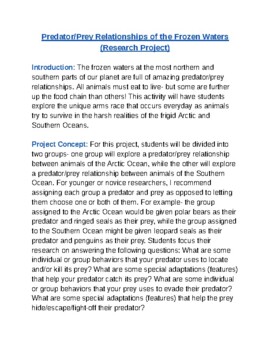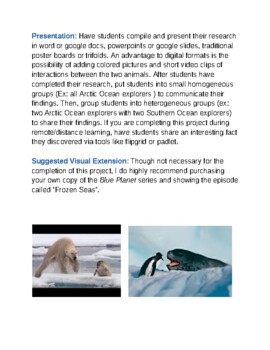Predator/Prey Relationships of the Frozen Waters (Research Project Outline)
Semenko Super Science
28 Followers
Grade Levels
4th - 10th, Homeschool
Subjects
Resource Type
Standards
CCSSRI.6.4
CCSSRI.6.7
NGSSMS-LS2-2
NGSSMS-LS1-4
Formats Included
- PDF
Pages
2 pages
Semenko Super Science
28 Followers
Description
This is a two page document overviewing a research project exploring predator/prey relationships in the frozen waters of the Arctic and Southern Oceans. Depending on the age and ability of your students, this project could take anywhere from 3-7 days. It is also an assignment that is easy to complete in an online learning or home school format.
Total Pages
2 pages
Answer Key
N/A
Teaching Duration
1 Week
Report this resource to TPT
Reported resources will be reviewed by our team. Report this resource to let us know if this resource violates TPT’s content guidelines.
Standards
to see state-specific standards (only available in the US).
CCSSRI.6.4
Determine the meaning of words and phrases as they are used in a text, including figurative, connotative, and technical meanings.
CCSSRI.6.7
Integrate information presented in different media or formats (e.g., visually, quantitatively) as well as in words to develop a coherent understanding of a topic or issue.
NGSSMS-LS2-2
Construct an explanation that predicts patterns of interactions among organisms across multiple ecosystems. Emphasis is on predicting consistent patterns of interactions in different ecosystems in terms of the relationships among and between organisms and abiotic components of ecosystems. Examples of types of interactions could include competitive, predatory, and mutually beneficial.
NGSSMS-LS1-4
Use argument based on empirical evidence and scientific reasoning to support an explanation for how characteristic animal behaviors and specialized plant structures affect the probability of successful reproduction of animals and plants respectively. Examples of behaviors that affect the probability of animal reproduction could include nest building to protect young from cold, herding of animals to protect young from predators, and vocalization of animals and colorful plumage to attract mates for breeding. Examples of animal behaviors that affect the probability of plant reproduction could include transferring pollen or seeds, and creating conditions for seed germination and growth. Examples of plant structures could include bright flowers attracting butterflies that transfer pollen, flower nectar and odors that attract insects that transfer pollen, and hard shells on nuts that squirrels bury.



